A team of archaeologists led by George A. Reisner excavated at Giza, Egypt, where they unearthed a remarkable ancient treasure. The scientists discovered the only complete ancient Egyptian bead-net dress found to date in one of the tombs! Most ancient Egyptian tombs have been looted, but the owner’s burial had remained undisturbed, giving archaeologists a unique opportunity to examine the incredible clothing.

The ancient treasure was found in a Giza tomb. Credit: George A. Reisner
Inside the Giza Mastaba tomb G7440 were the skeletal remains of an unidentified female. Riesner was a thorough archaeologist who photographed and documented everything inside the tomb. He also wrote a daily diary describing everything of importance concerning tomb G7440. Thanks to this diary and Riesner’s archaeological methodology and highly controlled recording techniques, scientists could reconstruct the incredible dress found in tomb G7440 60 years later.

As a research associate for a prospective MFA exhibit on the burial practices and funerary beliefs of the ancient Egyptians, I was assigned the task of solving the mystery tiny round boxes and their bead-contents. Some 7,000 of the latter, of varied color, size, and shape, suggested that I was dealing with an object of major proportion; but what form would these beads assume when restored to their original configuration? Millicent Jick recalls.
Sitting in the basement storage room of the Museum of Fine Arts in Boston, Jick read the archaeological diaries and counted and sorted the thousands of beads in the small boxes. He was trying to determine what it all meant. The fact he was familiar with large ancient bead-net burial shrouds was, of course, an advantage when trying to solve this ancient mystery.
Based on the written records, field-sketches and excavation photographs Jick and his fellow researchers gained a picture of the dress the ancient Egyptian woman wore. Scientists now had all the information they needed “for the final reassembly of the loose beads into a bead-net dress.” 1
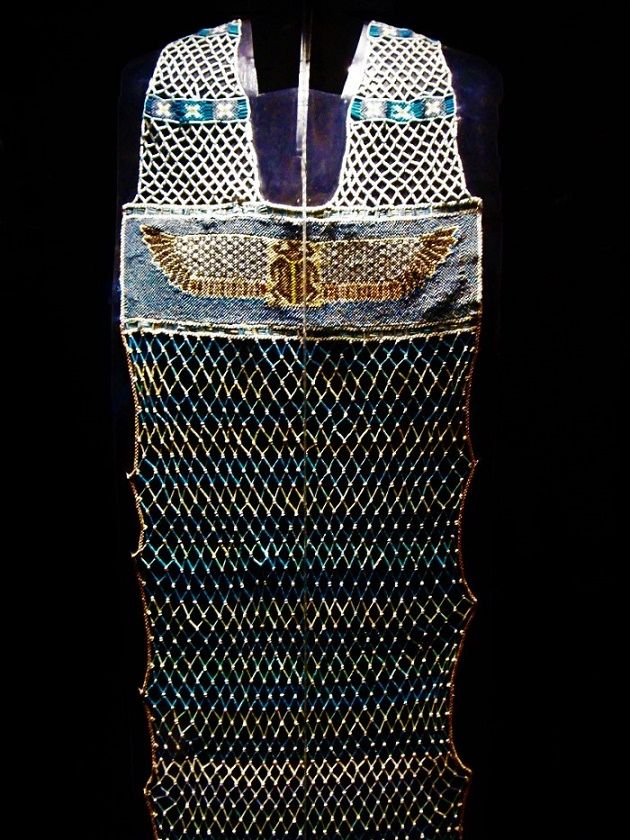
The 4,500-year-old dress was comprised of “several thousand faience beads divided among thirty small, rounds boxes of varied sizes, none larger than five inches in diameter.” 1
“This individual was wrapped, each limb individually, to simulate a living person, and covering her was the front half of a narrow V-necked sheath. Our final bead-net reconstruction produced, therefore, not a shroud-like mummy covering, but rather a dress that simulated a garment actually worn in life.
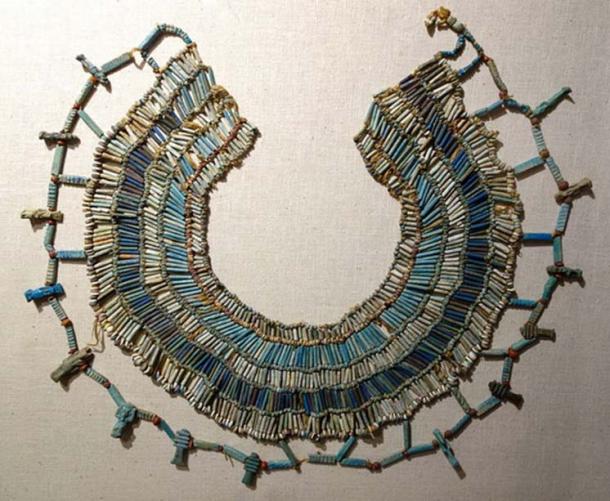
Beadnet dress – Egyptian Old Kingdom, Dynasty 4, reign of Khufu2551–2528 B.C.Findspot: Egypt, Giza, Tomb G 7440 Z. Credit: MFA Boston
I believe the MFA bead-net to be an important contribution to the field of Egyptian textile research and restoration,” Jick commented about the discovery and restoration of the incredible 4,500-year-old dress found in the Giza tomb.
Gaining a picture of how ancient people dressed and lived is naturally enjoyable. Several archaeological finds have provided scientists with clues about what fashion was like in prehistory. In ancient Egypt, garments and cloth were of great importance and intense colors were appreciated by rich and poor people.
“Clothing was an evident symbol of a person’s social position and wealth. It was also used as a form of security for a loan, given away as a mark of respect and honor, or left as a legacy.
Clothing that has already been worn was often reused.” 2
Linen was practical and worn during warmer and colder periods. The color white was, of course, useful in a hot climate. Ancient paintings discovered in Egyptian tombs give an overview of how people dressed. However, we must remember that poor people could never afford an elaborate burial like the elite, and it is hard to reconstruct their daily clothing.
Archaeologists have discovered ancient Egyptians liked stripy socks. Whether they invented them is premature, but they were undoubtedly one of the earliest civilizations that wore stripy socks. 3
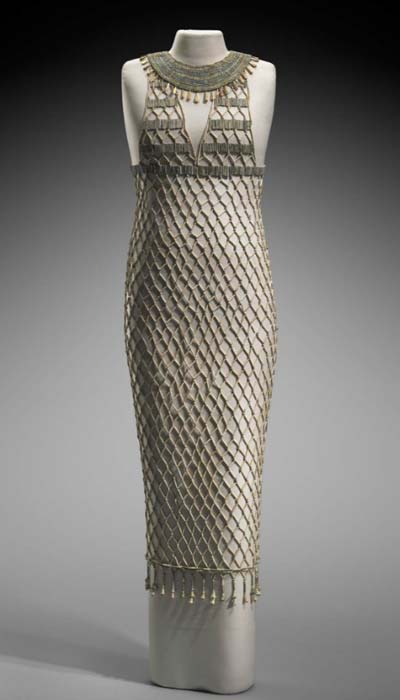
Stripy child’s sock dating from 300AD was found in a rubbish dump in Egypt. Photograph: The British Museum
Let’s not forget the incredible Tarkhan Dress when discussing ancient Egyptian clothing. This V-neck linen shirt has been confirmed as the world’s oldest woven garment, with radiocarbon testing dating the garment to the late fourth millennium B.C.

“The survival of highly perishable textiles in the archaeological record is exceptional, the survival of complete, or almost complete, articles of clothing like the Tarkhan Dress is even more remarkable. We’ve always suspected that the dress dated from the First Dynasty but haven’t been able to confirm this as the sample previously needed for testing would have caused too much damage to the dress,” Dr. Alice Stevenson, Curator at the UCL Petrie Museum of Egyptian Archaeology, said.
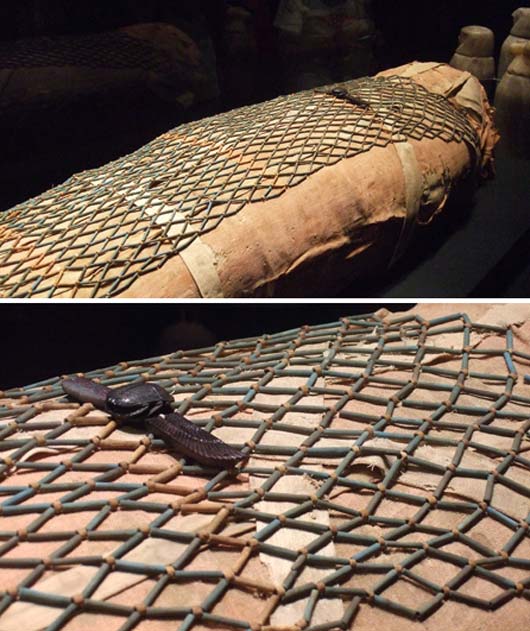
Although the dress was thought to be Egypt’s oldest garment and the oldest surviving woven garment in the world, the precise age of the dress was uncertain as previous carbon dating proved too broad to be historically meaningful. Credits: UCL Petrie Museum of Egyptian Archaeology.
Although the result is a little less precise than is now routinely possible through radiocarbon dating, as the sample was so small, it’s clear that the linen for the dress was made at the cusp of the First Dynasty or even earlier.”
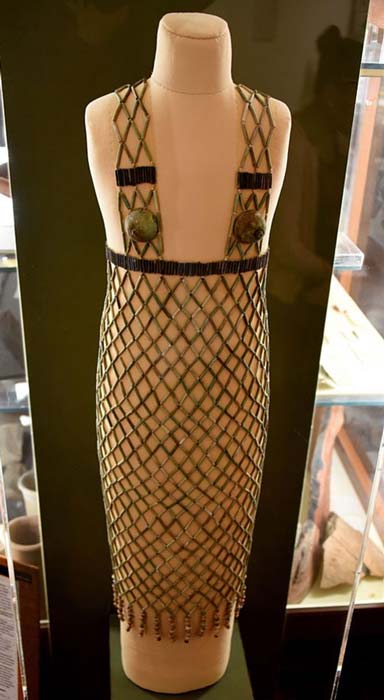
The dress itself is made from three pieces of sturdy hand-woven linen with a natural pale grey stripe with knife-pleated sleeves and bodice. The hem is missing, so it’s impossible to know the precise length of the dress, but the dimensions indicate that it fits a young teenager or a slim woman. Although the exact context of its use remains unclear, there are visible signs indicating that it was worn in life.” 4
Returning to the bead-net dress, we can end the story by saying we may never know the identity of the woman buried in Giza’s tomb G7440. Still, her memory has been preserved, and future generations will remember her thanks to the incredible bead-net dress she wore 4,500 years ago.





